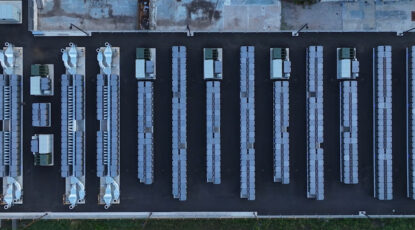If planet earth is to stand a chance of hitting the greenhouse gas emissions goals its political leaders agreed to in Paris in 2016, two things are certain: we’re going to need to generate a lot more electricity from clean and renewable sources, and we’re going to have to get better at storing renewable power so that it can be dispatched to the times and places where it is most needed.
Today, with non-hydro renewables providing just 10% of U.S. electricity, we already have excess generation of renewable electricity at the wrong times and in the wrong places. California curtailed enough renewable power in May 2019 to power 22,000 U.S. homes for a year. Germany and the UK have curtailed 4.4% and 5.6% of their wind power respectively in recent years. Texas also reported curtailment of renewables last summer. Meanwhile, the combustion of fossil fuels for power continues.
The problem is likely to intensify around the world as more renewables are added, unless we find better and more scalable solutions for balancing out supply and demand.
In some states and countries, hydrogen is one new option that is emerging as a compelling large-scale renewable storage medium.
A Cheaper, Cleaner, Larger-Scale Way to Store Renewables
Hydrogen. It’s what goes together with oxygen to make water. You can find it nearly everywhere on earth, the Moon, Mars, even drifting through outer space. (There is a LOT of it).
Splitting water to get to hydrogen is a very well understood piece of technology. Ever wonder where people on submarines get oxygen to breathe? Easy. Electricity splits water into oxygen and hydrogen. And, on the submarine people keep the oxygen and throw out the hydrogen.
On land, let’s reverse that. Use that extra electricity in California to split water. Let the oxygen loose into the air – or bottle it up and send it to hospitals. Store up the hydrogen! (The storing is easy – large tanks, underground caverns – even storing in the natural gas pipeline is possible.)
This blog from Proton OnSite nicely explains the electrolysis process. This article from Stanford University further explains how hydrogen could be produced from seawater. In fact, there already exist numerous commercially proven hydrogen generators. The International Energy Agency recently highlighted that 229 water electrolysis projects have come online since 2000.
Great, so we’ve created hydrogen from water using solar or wind power. Now what?
Well, we still need a technology that can convert that hydrogen back into electricity at a later date (likely at night, or when the wind stops blowing) in order to complete the storage/dispatch cycle. That’s where fuel cells come in.
Fuel cells convert hydrogen into electricity without combustion via an electrochemical process. And, the only bi-product? Water again.
Today, because hydrogen is generally unavailable at affordable prices, most fuel cells, including Bloom Energy’s solid oxide fuel cells, run on natural gas or biogas. Our systems make a hydrogen rich gas mixture from those gas types and use it internally with that electrochemical process we were mentioning.
In a future scenario where renewable hydrogen becomes available, most likely in areas of high renewables penetration, Bloom Energy Servers could run on the gas directly, thereby creating a perfect always-on renewable power source that acts symbiotically with intermittent wind and solar power.
Is this real?
The market for hydrogen as a fuel is still in its beginning stages, but expectations are rising.
Just this month the International Energy Agency released a report on The Future of Hydrogen at a G20 Ministerial Meeting. IEA analysis suggests that the cost of producing hydrogen from renewable electricity could fall around 30% in the next ten years, driven by falling renewables costs and increased production.
PV Magazine reports that as costs fall, the IEA believes hydrogen could become an important fuel in industrial ports, for power generation through greening natural gas supplies, and for transportation via fuel cell vehicles.
Some big bets have already been placed on hydrogen within the power generation industry.
One year ago, Hydrogène de France (HDF) announced a €90 million ($105 million) solar-powered hydrogen facility in French Guiana which it claimed would generate 10 megawatts in the daytime and 3 megawatts during the night, thanks to the coupling of fuel cells, hydrogen storage and solar arrays.
Advanced Clean Energy Storage announced a slightly different take on hydrogen storage in May 2019. The organization shared that it would install 1,000 megawatts of energy storage capacity in Utah. Excess grid power will be stored in the form of hydrogen in salt caverns located nearby. In this case, turbines capable of running on hydrogen will dispatch the stored energy when it is needed. It’s a utility scale model in the traditional centralized sense, but it shows the growing interest in the potential of hydrogen storage at scale.
Fuel Cells and Renewables: A Vital Partnership in the Race to Decarbonize
A key reason fuel cells could be so well matched to the rise of renewables is the distributed nature of renewable power. Power on the grid is becoming less concentrated with large nuclear or combustion power plants. It is rapidly becoming distributed to the places where the sun shines and wind blows.
Fuel cells are an equally flexible distributed power technology which can be sited in a compact footprint anywhere that renewable power or hydrogen are available.
So while today fuel cells and renewables each separately reduce greenhouse gas emissions, in the future they will work symbiotically to further reduce emissions by producing and generating electricity from hydrogen.
It’s a powerful prospect, and we’re excited to be playing our part in making it a reality.



